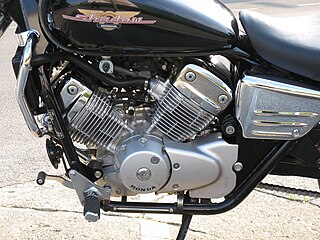
A V-twin engine, also called a V2 engine, is a twocylinder piston engine where the cylinders share a common crankshaft and are arranged in a V configuration.

A drive shaft, driveshaft, driving shaft, tailshaft, propeller shaft, or Cardan shaft is a component for transmitting mechanical power and torque and rotation, usually used to connect other components of a drivetrain that cannot be connected directly because of distance or the need to allow for relative movement between them.

The Lancia Prisma was a small family car built by Italian car manufacturer Lancia between 1982 and 1989. It was a saloon version of the first generation Lancia Delta hatchback, and like the Delta it was designed by Giorgetto Giugiaro. Like the Delta it was also available as a 4x4 integrale version, although with a non-turbocharged engine and an air-locking rear differential.
The following outline is provided as an overview of and topical guide to automobiles:
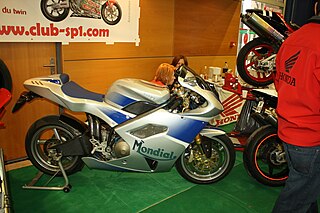
The Mondial Piega 1000 is an exotic, limited production Italian sport bike made by Mondial. The engine is from Honda, the same V-twin used on the VTR-1000 SP-1.
The Rover 8 was a small single-cylinder 8 hp 1327 cc car made by the British Rover car company. It was Rover's first production car. It was remarkable for being supported by a backbone chassis rather than a conventional ladder frame. The first model was manufactured from 1904 to 1912. A Daimler-Knight sleeve valve engine option was available on the original model in 1911 and 1912.

The TatraT813 was a truck produced in Czechoslovakia by the Tatra company. It was produced from 1967 to 1982. The basic representative of this series was a military version of the 8×8 Kolos (Colossus), which was able to pull trailers up to a total weight of 100 tons. Tatra also produced a civilian version in either 6×6 or 4×4. After fifteen years of production, 11,751 vehicles were built in all modifications. Many units were exported to the USSR, East Germany, Romania and India.

The Tatra 148 was a truck produced in Czechoslovakia by the Tatra company.

The Rover 6 was a small two-seater 6-horsepower car and only the second car model made by the British Rover car company. Announced in January 1905 a 6-horsepower car remained available from Rover until 1912.
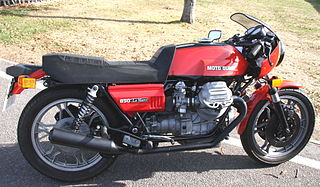
The Moto Guzzi Le Mans is a sports motorcycle first manufactured in 1976 by Italian company Moto Guzzi. It was named after the 24-hour motorcycle endurance race at Le Mans in France. The Le Mans designation was first used for an 850 prototype, based on the V7, displayed at Premio Varrone in late 1972.
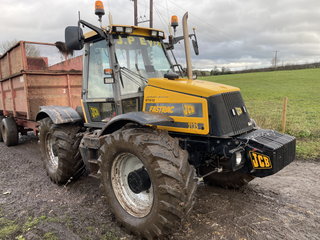
The JCB Fastrac is a high-speed agricultural tractor series manufactured by JCB Landpower, part of the JCB group.

The second generation of the Subaru Impreza compact car was introduced in 2000 and manufactured up to 2007 by Subaru in Ota, Gunma, Japan, in both sedan and five-door wagon bodystyles, as well as two intermediate facelifts throughout its lifespan.

Sisu K-44 is a three-axle 4×4+2 driven lorry made by the Finnish heavy vehicle manufacturer Suomen Autoteollisuus (SAT) from 1959 to 1965. The most usual applications were for log transportation and earth moving vehicles. The K-44 was noted for its excellent gradient capabilities. The legally permissible maximum vehicle payload was between 7 800 and 11 750 kg: with a trailer this increased to 20 000 kg. The K-44s were powered by Leyland diesel engines with power outputs of between 85.8 and 156.7 kW.

The Moto Guzzi 500 TriAlce is a three-wheeler Italian built by Moto Guzzi between 1940 and 1943 for the armed forces.
The Audi R8 LMS Cup was a one-make sports car racing series by Audi based in Asia. Audi R8 LMS Cup cars were based on the Audi R8 LMS (GT3).

ZT 300 is a series of 20 kN agricultural tractors, produced from 1 September 1967 to 1984 by the VEB Traktorenwerk Schönebeck. It succeeded the RS14 Famulus series, and unlike the Famulus, the ZT 300 series was sold under the brand name Fortschritt. ZT 300 refers both to the initial ZT 300 model, and the ZT 300 series. In total, 72,382 units of the ZT 300 series were made. The model with the highest production figure was the ZT 303, which was introduced in 1972. It features an automatic all-wheel-drive system; in the early 1980s, it cost 81.000 Mark. Starting in 1983, the ZT 300 series was succeeded by the ZT 320.

Fortschritt ZT 320 is a series of agricultural tractors made by the East German manufacturer VEB Traktorenwerk Schönebeck. It was produced from 1983 to 1990, and succeeded the ZT 300 series. Unlike its predecessor, the ZT 320 series came in only two models, the rear-wheel drive ZT 320, and the all-wheel drive ZT 323.

The V 85 TT is an Enduro motorcycle from Moto Guzzi, which belongs to the middleweight adventure bike category. The motorcycle was announced end of 2017 and entered production in spring 2019. It is supposed to combine classic styling with modern equipments and it targets road and light off-road use. This is reflected by the model name, where "TT" stands for "Tutto Terreno", which is Italian for "all terrain".
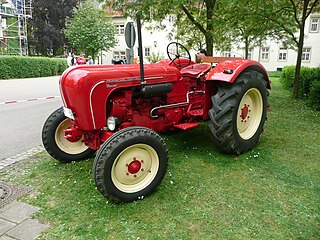
The Porsche-Diesel 419 is an agricultural tractor made by Porsche-Diesel Motorenbau, and part of Porsche's Master series. It was the biggest and most powerful series-production tractor ever sold under the Porsche brand. In total, 1175 units were produced from 1960 until 1963. The 419 was preceded by the 418, and had no successor, since Porsche-Diesel Motorenbau stopped producing tractors in 1963. That same year, the catalogue price for a Porsche-Diesel 419 was DM 15,290.


















